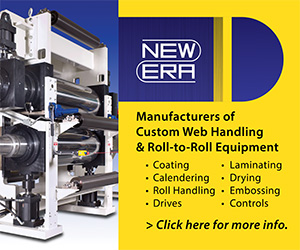Coating/Laminating
Hot Topics: Adhesive Coating | Extrusion Coating | Metallizing | Curing | Drying | Green Converting | Primers | Coatings
Comexi Joins CEFLEX And Reaffirms Its Commitment to Sustainability
- Published: October 02, 2020
Comexi, a specialist in solutions for the printing and converting industry of flexible packaging, has reaffirmed its commitment to sustainability and the circular economy by joining CEFLEX (Circular Economy for Flexible Packaging).
Soma Rolls Out a Turnkey Solution for Shipping and Rigging of Equipment Installed in the U.S. and Canada
- Published: September 21, 2020
SOMA, producer of flexographic printing presses, slitter rewinders and laminators, announces that it is rolling out a one-stop turnkey solution for the installation of its equipment
Karlville Launches Innovative Combi Laminator
- Published: September 08, 2020
Karlville, a manufacturer of the Pack Ready Laminator for HP Indigo, announced the launch of new laminator that combines both thermal and solventless adhesive lamination technologies.
Exploring New Options in More Sustainable Packaging Formulations
- Published: August 31, 2020
More and more consumers, brand owners and other stakeholders are now looking beyond the traditional three-arrow triangle “seal of approval” for recyclability on food packaging.
Avery Dennison Performance Tapes Releases Bonding Study With Superior Felt & Filtration
- Published: August 31, 2020
Avery Dennison Performance Tapes released the first in a series of bonding studies that make it easier for converters to evaluate the performance of Avery Dennison Core Series™ Portfolio
Michelman Announces Growing Portfolio of Biodegradable Products Institute (BPI) Certified Compostable Coatings
- Published: August 12, 2020
Michelman recently announced the certification of three high-performance products to help make design and performance needs a reality.
First Complete Remote Installation of a Comexi Laminator During COVID-19 Pandemic
- Published: June 18, 2020
During the COVID-19 pandemic, Comexi, a global supplier of solutions for the flexible packaging printing and converting sector, has remotely installed multiple machines in response to the increased production of its customers.
Film Extrusion Manual, Third Edition Now Available from TAPPI Press
- Published: May 06, 2020
A new stand-alone training resource is now available for professionals and operations personnel at all levels in the plastics film industry
BOBST Launches NOVA SX 550 LAMINATOR
- Published: April 28, 2020
The new NOVA SX 550 LAMINATOR features a highly modular design which can be configured with either transfer rollers or sleeves or monolithic/integral rollers.
thelmoco, Inc. Experiencing Surging Demand
- Published: April 23, 2020
Michigan-based thelamco, inc. announced today that it is experiencing surging demand for hook-and-loop fastener materials for securing medical Personal Protective Equipment (PPE) to aid first responders in the fight against COVID-19.
Wen Chyuan Brings Western Quality to Sheet Fed Lamination
- Published: April 20, 2020
Established in 1972 by engineer Lin Chi-I, Wen Chyuan Machinery Company has become one of the leading manufacturers of sheet fed varnishing
AIMCAL Announces Winners During Virtual Award Ceremony
- Published: April 17, 2020
The Association of International Metallizers, Coaters and Laminators (AIMCAL) presented its 2020 Sustainability Award during a special Virtual Awards presentation on Thursday, April 16.
Case Paper Acquires Laminating and Coating Facility in the Midwest
- Published: April 13, 2020
Case Paper recently announced that it has acquired the assets of the former API Laminating operation of Steel Partners in Osgood, Ind.
Faustel Leads the Converting Industry with Our In-House Technology Center
- Published: March 06, 2020
For over 60 years, the Faustel team has been responsible for innovative coating, laminating, and winding machinery in use world-wide.
Spartech Debuts Korad Flat Black Acrylic Film for Highly Esthetic Applications
- Published: February 28, 2020
Spartech announced the debut of Korad™ Flat Black Acrylic Film .







